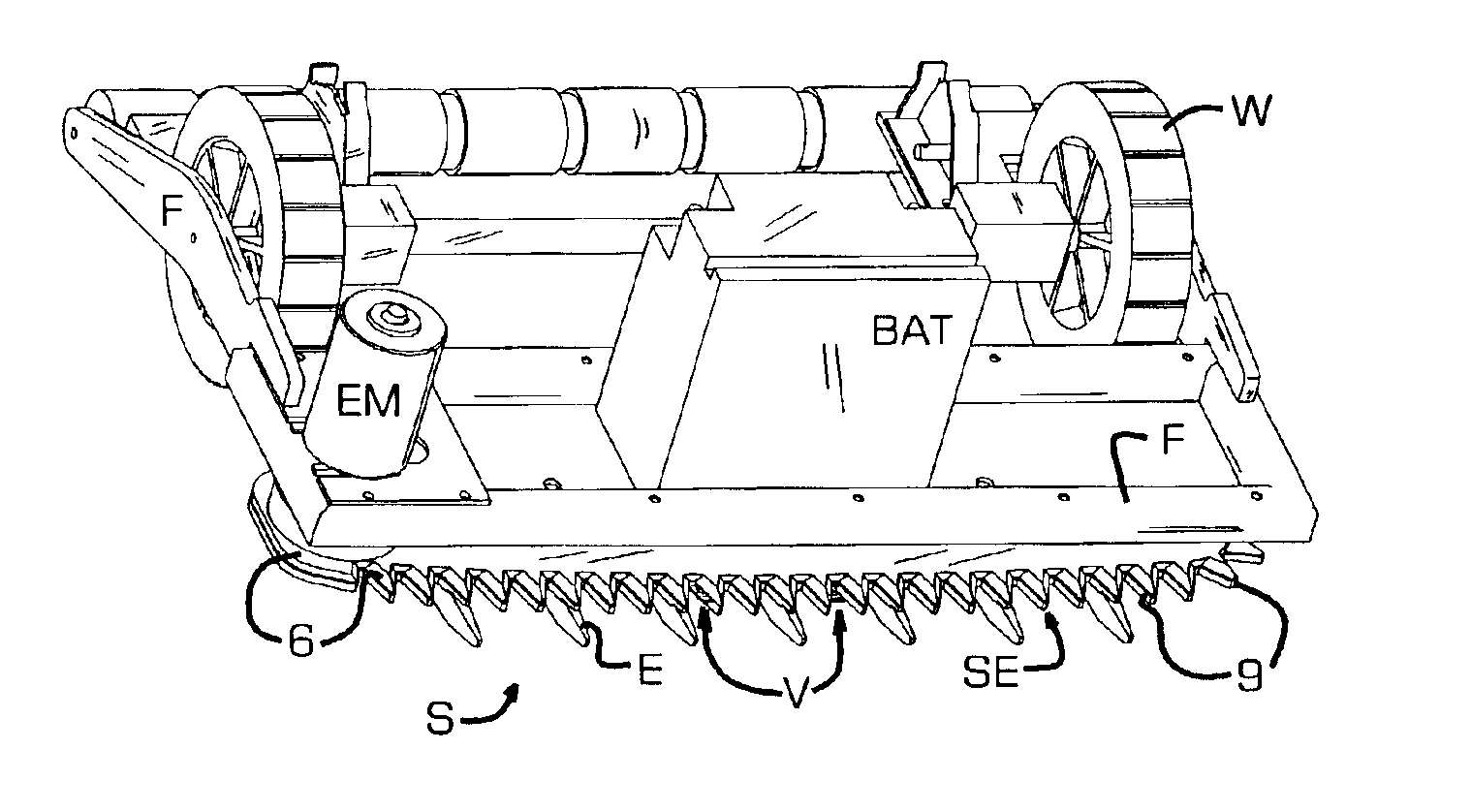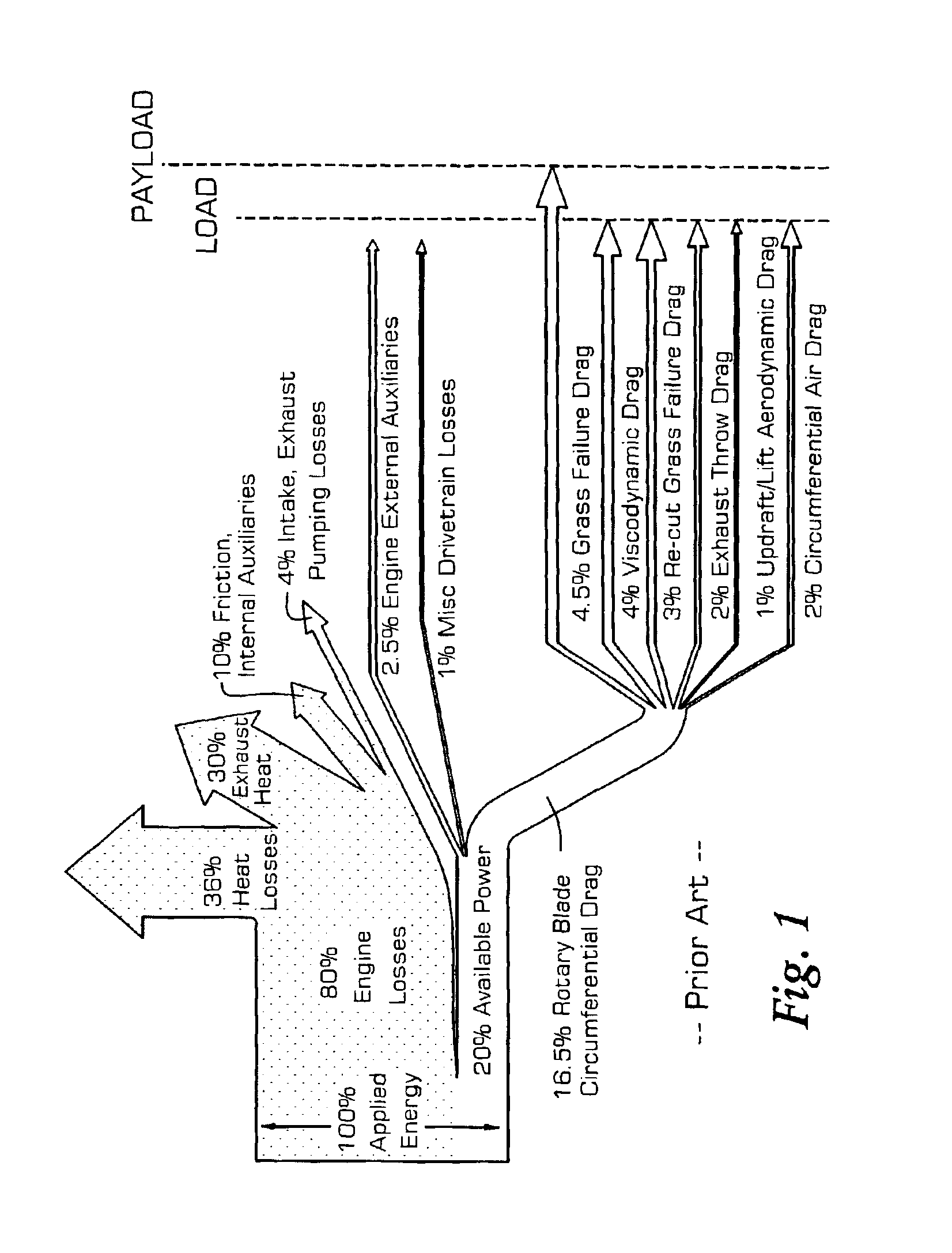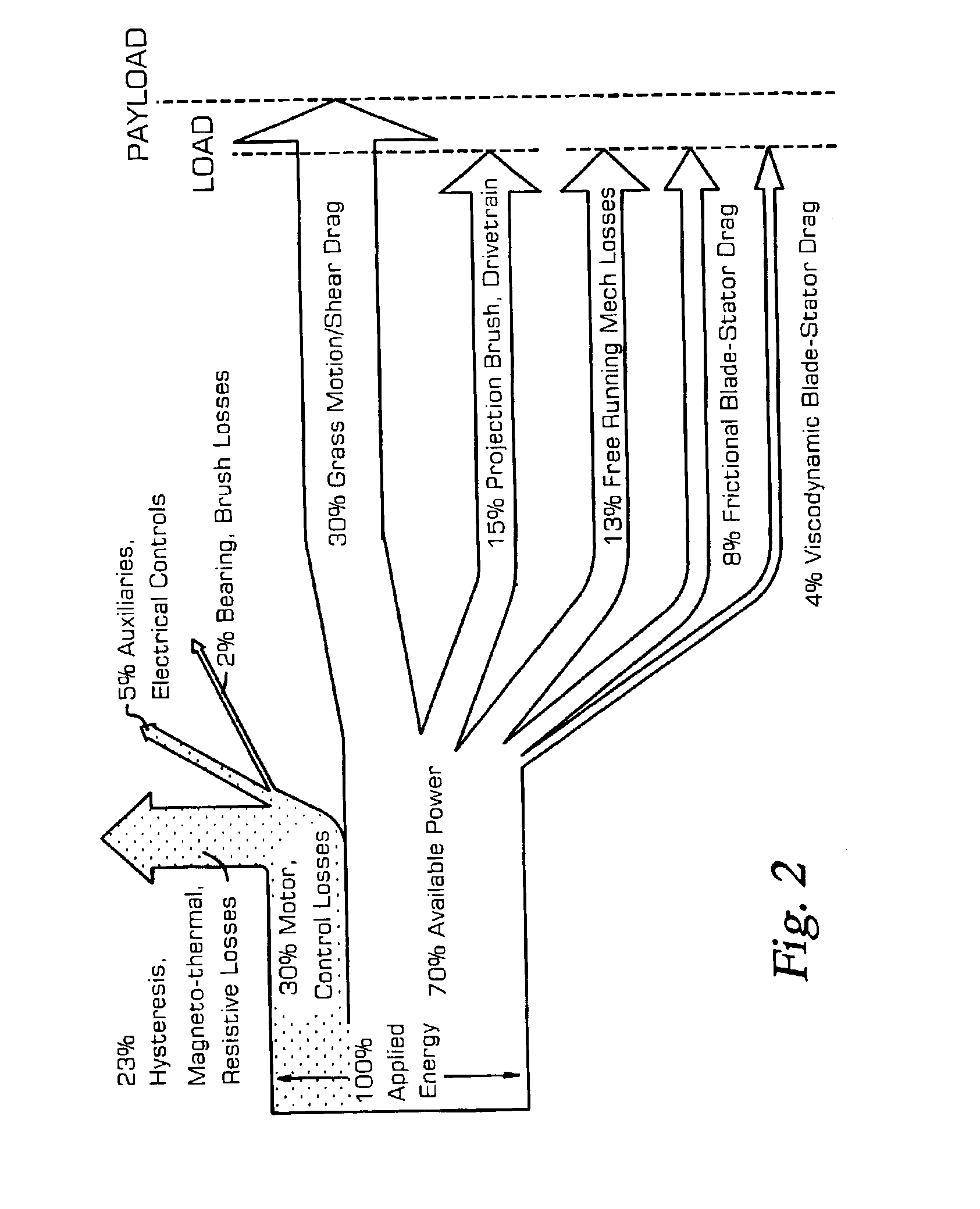Most of these machines are powered by small internal
combustion (IC) engines under 5 HP (3.7 kW) that are relatively unsophisticated and are a significant source of volatile organic hydrocarbons (VOCs),
carbon monoxide (CO), and particulate emissions.
Grass presents unique problems for the cutting arts.
Unlike most cutting done in the industrial arts, mowing grass is a complex process and involves a number factors.
The materials to be
cut are biological, unpredictable, arrayed at different angles, differing in
moisture content, and mechanical characteristics from grass blade to grass blade.
This affects the specific failure
modes for a grass blade under a cutting stress, and not all types of grass or conditions will allow for the same cutting behavior.
Material buildup on cutting surfaces and associated components is a well known problem, and
mower operator behavior can be unpredictable.
Further, in many cases, there is a significant amount of
cut material, often moist or wet, to be disposed of on the cutting field or into a receptable or bag.
But reel mowers have many disadvantages: they cannot cut all types of grasses or weeds or light
brush and they often need adjustment and
sharpening.
Relatively heavy, they are hard to maneuver and cannot cut grass close to walls or trees.
They have cumbersome and expensive drive trains, owing to the relatively slow rotational speed of the reel and the
horizontal orientation of its rotation axis.
They are more costly and require more maintenance and operator knowledge for successful mowing.
Furthermore, the shearing action used by reel mowers comes at the expense of high running friction between the spiral blades of the reel and the straight stationary blade that it contacts, due to the strong clamping force (inter-blade bias) needed to maintain successful shearing action, much as one endeavors to keep each blade of a pair of scissors tightly applied against one another to get a good cut.
With component wear, some adjustments are typically needed to maintain true shearing action.
Reel mowers are also extremely limited in their ability to
handle upsets from obstructions and non-negotiable
plant stalks, resulting in frequent jamming.
However, they are inherently dangerous and represent a domestic
hazard of the highest order for operators, producing thousands of injuries each year, many of a serious nature.
Often the
discharge chute and the nearby housing become clogged with grass clippings, rendering the
mower useless.
This tempts operators to either tilt the
mower to
expose the underside for cleaning or inspection, or to actually attempt to clean the affected area while the mower is running, both inviting severe and immediate danger.
Many operators are injured by deliberate or accidental placement of a foot under this housing, wherein the foot, or merely a shoe lace or pant
cuff projects sufficiently so as to be caught by the moving blade.
If the rotary mower is used inappropriately, such as has been done by some to lift it in the air to trim hedges and the like, it can maim and kill in seconds.
Furthermore, rotary mowers are basically crude and destructive chopping devices which rely on
impact cutting or tearing of the grass rather than shearing it cleanly, causing
plant damage which in turn causes
vulnerability to
disease,
moisture loss and pests, and causes the
lawn to have a brown cast after mowing.
Rotary mowers require blade
sharpening, and emit loud
noise, mostly due to the high IC engine output required and due to
windage losses, as the pitched blade is customarily designed to be used to create a strong updraft to insure grass blades are straightened and vertical for subsequent cutting.
The tensile failure cut given by a rotary mower requires more energy, and the
high torque capacity prime movers needed for most mowers generally, are wasteful, as discussed below.
However, prior art sickle mowers have important limitations.
Sharpening of the multiple sickle blades is relatively difficult, and usually requires specific component re-
assembly beyond the capability of most consumers.
Blade lifetimes are often limited and sickle bars containing the blades are often heavy and cumbersome.
Also, one often cannot obtain effective cutting for sickle mowers cutting grass, as some grass encountered on the cutting field tends to flatten or simply move in a way so as to avoid being trapped in the sickle mechanism.
Blades of grass that need a small amount of trimming, such as encountered when mowing a lawn regularly, are not always cut, as some blades of grass are not stiff enough to allow
mechanical resistance to motion that would cause them to enter the active sickle cutter; instead, selected grass blades are pushed aside or knocked aside as the mower passes, without being cut.
Between the planes established by the moving cutting blades and the
stator(s) there is a dimensional or spatial gap, which tends to be large, and therefore not conducive for cutting fine grass.
The large gap, discussed below, means that the actual failure mode tends to be a either: [1] tensile failure in the grass, which requires more energy to accomplish, and tends to cause grass damage as cited above; or if the sickle blade is kept sharp, [2] a knife cut, similar to an
impact cut, with some grass body cleavage from the sharpness of the sickle cutting blade.
In the sickle mower, there are challenges and considerations relating to
load management and dealing with obstructions, such as thick
brush, debris, sticks, or soft stalks.
This allowed for uninterrupted operation, but the energy required basically consigned sickle mowers to use of the same size and type of relatively large and wasteful
prime mover (typically a 3-5 HP IC engine) as used by reel and rotary mowers, with much of the same
high energy use, high
noise levels, high exhaust emissions, and
high weight and complexity associated with these traditional machines.
The high reserve torque needed by prior art sickle mowers not only results in energy wasted for running the
machine, but also the high transient forces developed by necessity to plow through, cut through, or otherwise eliminate obstructions as best as possible means that the cutting blades themselves, and possibly the
stator(s) digits or elements as well, have to be thick and of heavy construction to withstand shocks and to able to plow into obstructions without dings or damage.
This further increases the requirement for sharp blades, as they tend to be thick, and if presented to the grass on the cutting field in dull geometry, the mower stalls, fails to cut, or cuts in an
impact cut regime only, which limits its effectiveness and increases required blade lateral (cutting) velocity, further increasing the energy needed to run the mower.
Also, prior art sickle mowers, operating at high reserve torque to, in effect, have the cutting blades slam their way through grass and
brush, are not adapted or capable of managing non-negotiable obstructions without operator intervention, such as when the operator stops the mower and manually clears the obstruction, etc.
Also, the high reserve torque applied to the sickle cutting blades virtually assures that some safety issues remain, such as the danger of severing a finger accidentally interposed between the sickle cutting blade and
stator(s).
Furthermore, prior art sickle mowers using a single stator tend to rely on a the outcome of a single physical failure site on a blade of grass, that is, the cut must occur on at or near the particular pinch point or line created by the cutter(s).
The reliance on a single shear failure site changes unfavorably the cutting action
kinetics, making unsuccessful cutting events more likely.
Other problems with prior art sickle mowers include: [1] the buildup of secondary cutting products or debris on cutting blades, which tends to eventually impede facile operation.
Prior art teachings such as U.S. Pat. Nos. 5,557,913 and 5,706,639 to Metz disclose “C-shaped, channel-like” cutting blades or equivalent cutting elements, but none teach how to reduce troublesome buildup of secondary cutting products (grass bits, resins, etc.) from accumulating on those blades; [2] lingering problems of conditioning the grass to not bend or move out of the way of the moving cutter blades; [3] energy wasted by the necessity of having high blade numerical redundancy, whereby energy is wasted by having a large number of blade passes in cutting zones for a given amount of forward motion of the mower, to
mask or compensate for unsuccessful cutting events.
As a result, no commercially successful low energy sickle mower
system for
consumer use in caring for turfgrass has been heretofore devised.
 Login to View More
Login to View More  Login to View More
Login to View More 


